Explore Penang - Malaysia Travel, Asia
Penang, Malaysia’s famed “Pearl of the Orient,” is where heritage, flavors, and coastal beauty meet. This island state blends centuries of history with a vibrant present, creating a destination that charms both first-time visitors and returning travelers. From the UNESCO-listed streets of George Town to golden beaches, bustling night markets, and a street food culture celebrated worldwide, Penang offers a journey through time, taste, and tradition.
Population: Approximately 1.77 million in 2020.
Economy: Penang’s economy is driven by electronics manufacturing, shipping, and trade, earning the nickname “Silicon Valley of the East.” The state is also a thriving hub for tourism. Beyond industry and tourism, Penang has a growing services sector, including finance, healthcare, and education, making it a well-rounded and resilient economy.
Landmarks: Famous for the Kek Lok Si Temple, Penang Hill, and the Penang National Park.
Malaysia
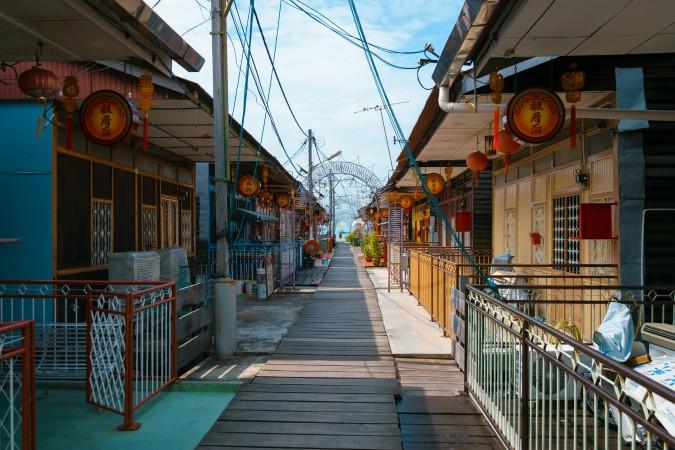
Overview of Penang
History & Cultural Influence
Penang’s story is a tapestry woven from Malay roots, Chinese migration, Indian trade, and European colonization. Founded as a British trading post in 1786, George Town quickly grew into a bustling port linking Southeast Asia to the world. Merchants from China, India, Arabia, and Europe left their mark on the island’s culture, architecture, and cuisine.
The historic center of George Town, now a UNESCO World Heritage Site, reflects this multicultural past. Colonial mansions stand beside Chinese clan houses, while ornate temples share the skyline with mosques and churches. Streets carry names in Malay, English, and Chinese, echoing the coexistence of communities.
Interaction with the Locals
Penangites are known for their warmth and easygoing charm. Strike up a conversation at a kopitiam (traditional coffee shop), and you’ll often be met with a smile and a story. Locals take pride in their heritage, eager to share recommendations on the best laksa stall or hidden street art corner. Joining a cooking class, attending a Hokkien opera during a temple celebration, or visiting a family-run spice shop can turn sightseeing into cultural immersion.
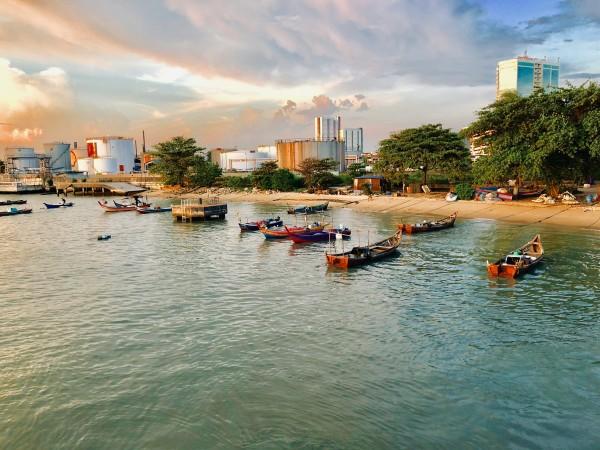
Top Attractions in Penang
George Town Street Art
The historic streets of George Town double as an open-air gallery. Murals by Lithuanian artist Ernest Zacharevic and local talents turn walls into storytelling canvases. From the iconic Kids on Bicycle to playful steel-rod sculptures, each piece reflects Penang’s culture and humor. Bring your camera, as this is one of the most photographed areas on the island.
Kek Lok Si Temple
Crowning the hills of Air Itam, Kek Lok Si is one of Southeast Asia’s largest Buddhist temples. Its seven-tier Pagoda of Rama VI blends Chinese, Thai, and Burmese design. Lantern-filled courtyards and the towering bronze statue of the Goddess of Mercy create a serene yet awe-inspiring atmosphere.
Penang Hill
A cool escape from the city heat, Penang Hill offers panoramic views of George Town, the mainland, and the Straits of Malacca. Ride the funicular railway through lush rainforest, then enjoy colonial-style bungalows, gardens, and nature trails at the summit.
Penang National Park
On the island’s northwest tip lies Penang National Park, one of the world’s smallest yet most diverse nature reserves. Trails lead to secluded beaches, such as Monkey Beach and Kerachut Beach, where a rare meromictic lake appears seasonally. Birdwatchers and nature lovers will feel right at home.
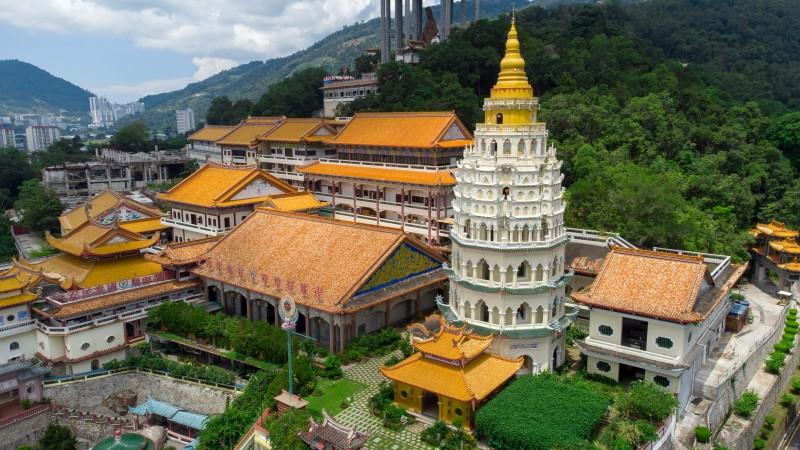
Must-Try Dishes in Penang
- Char Kway Teow: This smoky stir-fry of flat rice noodles, prawns, cockles, Chinese sausage, and bean sprouts is cooked over high heat for a charred, caramelized flavor known as wok hei. Often served on banana leaves at street stalls in George Town and Lorong Selamat.
- Penang Assam Laksa: A bold, sour fish-based noodle soup made with mackerel, tamarind, torch ginger, and mint. Its intense flavors are balanced with a drizzle of shrimp paste (heh ko). The version from Air Itam Market is a local favorite.
- Nasi Kandar: A dish born from Indian Muslim heritage. It features steamed rice topped with a medley of thick curries, fried chicken, beef rendang, okra, and hard-boiled eggs.
- Hokkien Mee (Prawn Noodle Soup): This comforting bowl blends prawn and pork broth with yellow noodles, prawns, egg, kangkung, and sambal. Rich, aromatic, and perfect for breakfast or a light dinner.
- Cendol: A traditional dessert of shaved ice topped with green pandan jelly, red beans, coconut milk, and gula Melaka (palm sugar syrup). A bowl of Penang Road Famous Teochew Chendul is a must on a hot day.
- Rojak: A sweet-spicy fruit and vegetable salad. Pineapple, cucumber, jicama, and fried tofu are tossed in a sticky black shrimp paste dressing with crushed peanuts. It's messy, bold, and addictive.
- Penang Roti Canai: Crispy on the outside, soft and flaky inside, this Indian-inspired flatbread is served with dhal or curry. It's a local breakfast staple, often enjoyed with a teh tarik (pulled milk tea).
- Lor Bak: A Chinese-style meat roll made from marinated pork wrapped in bean curd skin and deep-fried until golden. Served with a side of chili sauce and thick starchy gravy (lor).
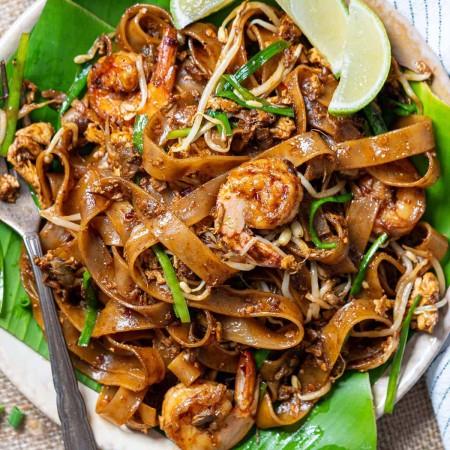
Festivals & Local Celebrations
George Town Festival
Held every August, this month-long arts and culture festival celebrates creativity in all forms: music, theatre, photography, dance, and street performance. It transforms George Town into a dynamic stage, drawing both local talents and international acts.
Don’t miss: Public art installations, cultural workshops, and pop-up exhibitions in heritage buildings.
Chinese New Year
In January or February, Penang lights up with fireworks, lion dances, and red lanterns. Temples overflow with offerings and blessings. The Penang Chinese New Year Celebration (Miao Hui) in George Town is the highlight, turning heritage streets into festive zones filled with traditional games, food stalls, and live performances.
Thaipusam
One of Malaysia’s most visually striking festivals, Thaipusam is celebrated by the Tamil Hindu community in late January or early February. Devotees carry kavadis, decorated structures, on a pilgrimage from George Town to the Waterfall Hilltop Temple. The procession is intense, spiritual, and unforgettable.
Hari Raya Aidilfitri
Marking the end of Ramadan, this major Muslim celebration is a time of forgiveness, family gatherings, and festive food. Many locals host open houses, welcoming visitors with rendang, ketupat, and kuih (Malay sweets).
Deepavali
Known as the Festival of Lights, Deepavali is celebrated by the Indian community with oil lamps, colorful kolam art, and temple prayers. Little India in George Town bursts with lights, music, and sweet treats during this joyful occasion.
Wesak Day
Observed in May, Wesak Day marks the birth, enlightenment, and death of the Buddha. Monks lead candlelight processions through the city, particularly at Kek Lok Si Temple, where thousands of lights illuminate the night.
Hungry Ghost Festival
In the seventh lunar month (usually August), locals believe spirits roam the earth. Offerings of food, incense, and paper goods are made to appease the dead. Street operas and puppet shows are performed for the wandering souls, adding a mystical edge to Penang’s cultural calendar.
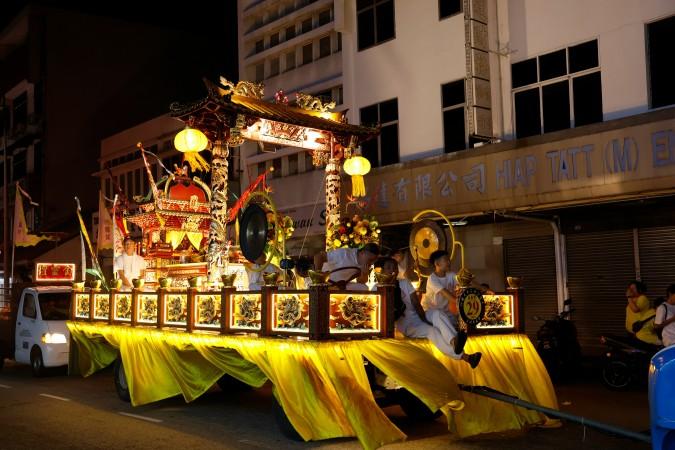
What to Do in Penang
- Heritage Walks in George Town: Explore George Town’s UNESCO-listed core on foot. Wander through Lebuh Armenian, Love Lane, and Muntri Street to discover street art, historical shophouses, Chinese clan temples, and British colonial buildings. Join a guided tour or pick up a heritage map to follow your own trail.
- Join a Penang Cooking Class: Dive into the heart of Penang’s culture by learning to cook local dishes like Char Kway Teow, Nyonya curry, and Kuih Seri Muka. Local chefs often share not only recipes but also family stories and food history.
- Visit Tropical Spice Garden: Located in Teluk Bahang, this lush 8-acre garden is home to over 500 plant species. Take a self-guided or guided tour to learn about herbs, spices, and traditional uses. Great for nature lovers and culinary fans alike.
- Experience the Penang Peranakan Mansion: Step into the lavish lifestyle of the Straits Chinese (Baba Nyonya) community. This museum showcases intricately carved furniture, traditional costumes, and family heirlooms in a restored 19th-century mansion.
- Relax at Batu Feringghi Beach: Unwind with sun, sand, and sea at Penang’s most famous beach. Water activities like jet skiing, parasailing, and banana boat rides are popular. In the evening, explore the Batu Feringghi Night Market for souvenirs and street snacks.
- Take a Funicular Ride up Penang Hill: At over 800 meters above sea level, Penang Hill offers cool air, panoramic views, a colonial mansion, and The Habitat at a rainforest discovery park with canopy walks and guided nature experiences.
Shopping in Penang
- Batu Feringghi Night Market: Stretching along the main road near the beach, this market is popular for handmade souvenirs, clothing, bags, watches, and local trinkets. Bargaining is expected, and the atmosphere is lively and casual.
- Armenian Street & George Town Souvenir Shops: The best place to find locally made crafts, Peranakan jewelry, hand-drawn postcards, and batik prints. Many shops are run by local artists who are happy to share the stories behind their work.
- Chowrasta Market: A Penang institution for local flavors. Find pickled fruits, nutmeg balm, traditional biscuits, and snacks. Head upstairs for affordable clothing, vintage goods, and old-school charm.
- Gurney Plaza & Gurney Paragon: Two of Penang’s most upscale malls, located on Gurney Drive. They offer international brands, beauty products, electronics, and air-conditioned comfort, a nice break from the tropical heat.
- Queensbay Mall: Located near the Penang Bridge, it’s one of the largest malls in northern Malaysia. Great for family shopping, dining, and indoor entertainment.
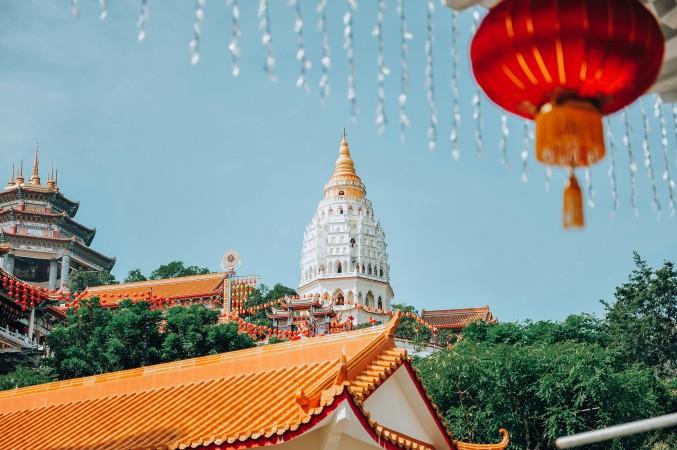
Weather in Penang: Best Time to Visit
Average daily temperatures range between 26°C and 32°C (79°F to 89°F), making it pleasant for sightseeing, though travelers should always be prepared for sudden rain showers.
Dry Season in Penang (December – March)
This is considered the best time to visit Penang. Skies are clear, rainfall is low, and the weather is ideal for outdoor activities like heritage walks, hiking at Penang Hill, or exploring Penang National Park. It is also the peak tourist season, so expect larger crowds and higher hotel prices.
Inter-Monsoon Season in Penang (April – May, September – November)
These transitional months bring short, heavy downpours—often in the late afternoon. Rain rarely lasts all day, so you can still enjoy sightseeing, but it’s wise to pack an umbrella or light raincoat. This period is excellent for indoor activities such as museum visits, shopping, and food hunting at hawker centers.
Southwest Monsoon in Penang (June – August)
Rainfall is lower during these months compared to other monsoon seasons in Malaysia. Mornings and evenings are usually sunny, making it a great time for beach trips, island-hopping, and water sports at Batu Feringghi.
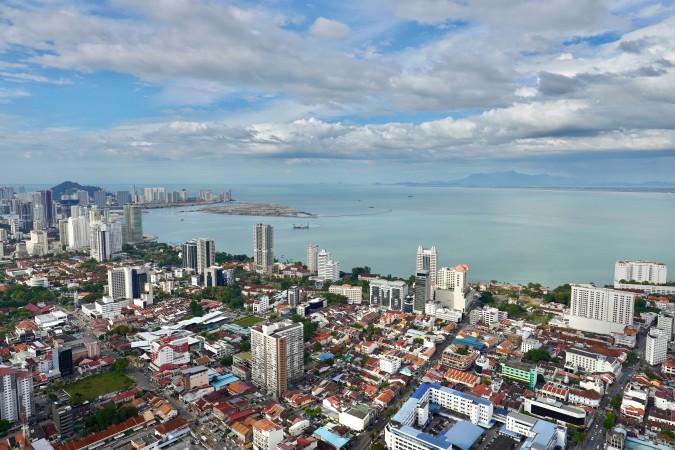
Essential Travel Information
Getting Around Penang
- Rapid Penang Buses: Rapid Penang is the island’s public bus system, covering major attractions, neighborhoods, and even routes to the mainland. Buses are air-conditioned and budget-friendly, making them a great option for tourists.
- Ride-Hailing Apps (Grab): Grab is widely used in Penang and offers a safe, cashless, and convenient way to get around. Prices are affordable and service is available across the island.
- Trishaws (Rickshaws): For a heritage experience, hop on a trishaw in George Town. These three-wheeled pedal taxis let you explore the old town at a relaxed pace. Negotiate the price before the ride.
- Taxis: Taxis are available but may not always use the meter. Agree on a fare beforehand or opt for Grab for a clearer price.
- Scooter or Bicycle Rental: Renting a motorbike or bicycle is popular among independent travelers. Roads in George Town are scooter-friendly, and bike tours around Balik Pulau or along coastal paths are scenic and enjoyable.
ATM & Banking Services
ATMs are widely available in shopping malls, petrol stations, banks, airports, and even convenience stores (like 7-Eleven or 99 Speedmart). Most machines accept international cards such as Visa, Mastercard, Cirrus, and Plus networks. Always choose to be charged in Malaysian Ringgit (MYR) when withdrawing cash to avoid poor exchange rates from your home bank.
Where to Stay in Penang
- Heritage Hotels: Stay in beautifully restored colonial mansions and Peranakan homes turned boutique hotels. Perfect for travelers who appreciate culture, history, and walking access to Penang’s best cafes, murals, and temples.
- Beach Resorts: Ideal for families, honeymooners, or anyone wanting a tropical escape. Enjoy sea views, spas, pools, and easy access to the Batu Feringghi Night Market.
- Budget Hostels & Guesthouses: Penang has a thriving budget travel scene, especially around Chulia Street in George Town. Many hostels offer clean beds, air-conditioning, shared kitchens, and friendly social vibes.
- Luxury Hotels: For travelers seeking comfort, world-class facilities, and service, Penang has a selection of 5-star hotels in strategic locations, near beaches or the city center.
Articles for you

Explore Yala National Park - Sri Lanka Travel, Asia
Tucked away in Sri Lanka’s southeastern corner, Yala National Park is where wild nature meets deep tradition. Known worldwide for its leopard population, the park is also home to elephants, sloth bears, crocodiles, and hundreds of bird species. Beyond wildlife, Yala opens doors to a cultural landscape dotted with ancient temples, Buddhist ruins, and coastal villages. For travelers seeking more than just a safari, Yala offers a chance to explore eco-tourism, local communities, and sacred heritage sites.
Population: The Yala National Park area doesn’t have a human population.
Economy: The economy around Yala National Park thrives on a blend of eco-tourism, agriculture, and local services. Safari tours, eco-lodges, and cultural experiences drive steady income for nearby towns like Tissamaharama and Kataragama, supporting thousands of families.
Landmarks: Famous for Block I of Yala and wildlife encounters, including elephants, sloth bears, crocodiles, and exotic bird species.

Explore Galle - Sri Lanka Travel, Asia
Nestled on Sri Lanka’s southern coastline, Galle is a vibrant city where history meets the sea. Its cobbled streets, colonial architecture, and serene beaches make it a must-visit destination for travelers seeking a blend of culture, adventure, and relaxation. A UNESCO World Heritage site, Galle captivates visitors with its Dutch Fort, bustling markets, and friendly locals. Whether you’re exploring the ramparts at sunset or savoring fresh seafood by the shore, Galle promises an unforgettable journey into Sri Lanka’s heritage.
Population: Approximately 113,000 in 2023.
Economy: Galle’s economy thrives on tourism, trade, and fisheries. The city’s historic fort, colonial architecture, and coastal charm draw thousands of international visitors each year, making tourism its main economic driver. Fishing remains vital for local livelihoods, supplying fresh seafood across the region.
Landmarks: Famous for the Galle Fort, Dutch Reformed Church & Maritime Museum, and Unawatuna Beach.

Explore Bentota - Sri Lanka Travel, Asia
Nestled along Sri Lanka’s southwestern coast, Bentota is a tropical paradise that blends golden beaches, vibrant culture, and thrilling adventures. Famous for its calm waters, luxury resorts, and scenic river estuary, Bentota has become a top destination for travelers seeking both relaxation and authentic experiences. From serene beach walks at sunrise to adrenaline-pumping water sports, this coastal town offers a perfect balance of leisure and exploration. With its proximity to Colombo and Galle, Bentota is easy to reach, making it an ideal stop for both short escapes and extended holidays.
Population: Approximately 37,000 in 2023.
Economy: Bentota’s economy thrives mainly on tourism, which drives local businesses such as hotels, restaurants, and wellness retreats. The town also benefits from fishing, coconut cultivation, and handicrafts like wood carving and batik textiles. Many residents rely on the growing demand for water sports and Ayurvedic treatments, making tourism the backbone of both income and employment in the area.
Landmarks: Famous for Bentota Beach, Bentota River Safari, and Kande Vihara Temple.

Explore Mirissa - Sri Lanka Travel, Asia
Mirissa is a charming coastal town on Sri Lanka’s southern shoreline. Known for its golden beaches, turquoise waters, and vibrant marine life, it has become a must-visit stop for travelers exploring the island. Many come for whale watching, surfing, and sunset views at Coconut Tree Hill, but Mirissa offers much more than postcard beauty. The fishing boats you see anchored by the bay carry generations of stories. Local traditions, delicious cuisine, and a laid-back rhythm of life shape every visitor’s experience.
Population: Approximately 4,700 in 2023.
Economy: Mirissa’s economy is largely shaped by its coastal location. Fishing has long been the backbone of local livelihoods, with generations relying on the Indian Ocean for income. In recent decades, tourism has become the main driver of growth, thanks to whale watching, surfing, and beachside hospitality.
Landmarks: Famous for Mirissa Beach, Coconut Tree Hill, and Parrot Rock Bridge.

Explore Nuwara Eliya - Sri Lanka Travel, Asia
Tucked away in the Central Highlands of Sri Lanka, Nuwara Eliya is often called “Little England”. With its rolling tea plantations, cool misty mornings, and colonial charm, this mountain town feels like a step into another world. Travelers come here to breathe fresh air, walk through flower gardens, sip the finest Ceylon Tea, and enjoy a pace of life far from the island’s busy cities. Whether you’re drawn by scenic landscapes, heritage architecture, or the warmth of its people, Nuwara Eliya is a destination that blends nature, culture, and history in perfect harmony.
Population: Approximately 781,000 in 2023.
Economy: Nuwara Eliya’s economy thrives mainly on tea production, as it sits in the heart of Sri Lanka’s central highlands, famous worldwide for Ceylon Tea. The city also benefits from a growing tourism industry, attracting visitors with its colonial charm, cool climate, and scenic landscapes.
Landmarks: Famous for Gregory Lake, Hakgala Botanical Garden, and Victoria Park.

Explore Sukau - Malaysia Travel, Asia
Nestled on the banks of the Kinabatangan River in Sabah, Malaysian Borneo, Sukau is a destination where wildlife, culture, and conservation come together. Known as one of Asia’s top spots for river safaris and eco-tourism, this quiet village offers a front-row seat to encounters with Bornean orangutans, pygmy elephants, proboscis monkeys, and exotic birdlife.
Population: Approximately 1,400 in 2019.
Economy: Sukau’s economy is shaped by its riverine location and natural resources. Traditionally, the Orang Sungai community relied on fishing, small-scale farming, and forest gathering for their livelihood. Today, the village has shifted toward eco-tourism, with river cruises, jungle trekking, and homestays providing income.
Landmarks: Famous for the Kinabatangan River cruises, Gomantong Caves, and Ox-bow lakes and wetlands.
